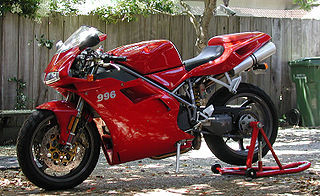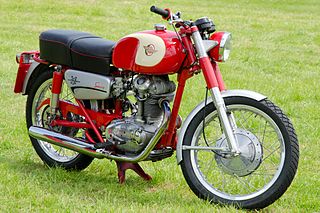
The Ducati 996 is a Ducati sport bike motorcycle made from 1999 to 2002, based upon the earlier 916.

The Ducati singles were single cylinder motorcycles, made by Ducati from 1950 to 1974. Chief Engineer Fabio Taglioni developed a desmodromic valve system in these years, a system that opens and closes the valves using the camshaft, without the need for valve springs. This valve system has become a trademark feature of Ducati motorcycles.

The L-twin is a naturally aspirated two-cylinder petrol engine by Ducati. It uses a 90-degree layout and 270-degree firing order and is mounted with one cylinder horizontal.

The 125 Bronco is a tubular steel/full-duplex-framed, base model motorcycle made by Ducati from 1960 to 1966, produced mainly for American distributor Berliner Motor Corporation. It was the second to last example, before the Ducati 125 Cadet/4, of Ducati pushrod technology which began in 1952 with the pressed-frame Ducati 98 models, which themselves had followed the Cucciolo T3, pull-rod and pushrod design singles.

Berliner Motor Corporation was the US distributor from the 1950s through the 1980s for several European motorcycle marques, including Ducati, J-Be, Matchless, Moto Guzzi, Norton, Sachs and Zündapp, as well as selling Metzeler tires. Berliner Motor was highly influential as the voice of the huge American market to the motorcycle companies they bought bikes from, and their suggestions, and sometimes forceful demands, guided many decisions in Europe as to which bikes to develop, produce, or discontinue.
Joe Berliner [...] a man endowed with great decision-making power in Borgo Panigale

The Ducati 98, 98N, 98T, 98TL, 98 Sport (98S) and 98 Super Sport (98SS) were a series of single-cylinder OHV, open-cradle pressed-steel frame motorcycles made by Ducati Meccanica from 1952 to 1958. The 98 Sport sold in London in 1956 for £178 10s, which would be £4,740 as of 2023, after inflation.
The Ducati 160 Monza Junior is a 152 cc (9.3 cu in) single cylinder bevel drive SOHC motorcycle produced by the Italian manufacturer Ducati from 1964 to 1970. The model was the most successful of the Ducati OHC singles. The exact number produced is not known, but estimates put the figure between 13,000 and 15,000. This exceeds the total number of all other Ducati singles produced from 1967 to 1975.

The Ducati Sebring is a 340 cc (21 cu in) single cylinder bevel drive SOHC motorcycle produced by the Italian manufacturer Ducati from 1965 to 1968. At the time of its introduction it was the largest capacity Ducati machine. Production of the original model ended in 1967 when the 'wide case' Mark 3 was introduced, although just over 200 Sebrings were made in 1968 with the 'wide case' engine. Total production was around 3,500 machines.

The Ducati 350 Mark 3 is a 340 cc (21 cu in) single cylinder bevel drive SOHC motorcycle produced by the Italian manufacturer Ducati from 1968 to 1974. It was one of the first 'wide case' Ducati singles produced. A higher performance version, the Ducati 350 Mark 3D, which used desmodromic valves was also available.
The Ducati 450 Mark 3 is a 436 cc (26.6 cu in) single cylinder bevel drive SOHC motorcycle produced by the Italian manufacturer Ducati from 1969 to 1974. The 450 was largest displacement version of the OHC single series produced by Ducati and used the 'wide case' engine. A higher performance version, the Ducati 450 Mark 3D, which used desmodromic valves was also available. The 450 was criticised for vibration and lack of performance compared to other models such as the Mach 1.

The Ducati 250 Mark 3 is a 249 cc (15.2 cu in) single cylinder bevel drive SOHC motorcycle produced by the Italian manufacturer Ducati from 1967 to 1974. Initially produced using the 'narrow case' engine, the newly introduced 'wide case' engine was used from 1968. A higher performance version, the Ducati 250 Mark 3D, which used desmodromic valves was also available.
The Ducati Monza is a 249 cc (15.2 cu in) single cylinder bevel drive SOHC motorcycle produced by the Italian manufacturer Ducati from 1961 to 1968. It was the touring version of Ducati's first 250 cc road bike. Reviews of the Monza praised its speed, road holding, engine smoothness and brakes.
The Ducati Diana, known as the Ducati Daytona in the UK, is a 249 cc (15.2 cu in) single cylinder bevel drive SOHC motorcycle produced by the Italian manufacturer Ducati from 1961 to 1964. It was the sports version of Ducati's first 250 cc road bike. It was replaced in 1962 by the higher performance Ducati Diana Mark 3 in the US and by the Ducati Mach 1 in Europe in September 1964.
The Ducati Diana Mark 3, also known as the Ducati Diana SuperSport and commonly referred to as the Ducati Mark 3, is a 249 cc (15.2 cu in) single cylinder bevel drive SOHC motorcycle produced by the Italian manufacturer Ducati from 1962 to 1966. It was a higher performance version of the Ducati Diana and sold to the American market only. In 1963, Cycle World described it as "the fastest, and nearly the smoothest, standard motorcycle in the 250cc class". It was replaced in 1967 by the Ducati 250 Mark 3.
The Ducati 250 GT, also known as the Ducati Daytona GT in the UK, is a 249 cc (15.2 cu in) single cylinder bevel drive SOHC motorcycle produced by the Italian manufacturer Ducati from 1964 to 1966. At the time of its launch it was the least powerful of Ducati's range of 250 cc machines.

The Ducati 450 R/T (road/trail) is a 436 cc (26.6 cu in) single cylinder bevel drive desmodromic SOHC motorcycle produced by the Italian manufacturer Ducati from 1971 to 1974. Initially produced at the request of the American importers Berliner Motor Corporation as a pure motocross machine exclusively for the American Market, only a few hundred machines were made of this type. It is the only motocross bike to use desmodromic valves. An optional street equipment kit was available. From 1972 it was produced for the European Market as a street legal on/off road machine, which was sometimes known as the 450 T/S.

The Ducati 250 Scrambler, known in Europe as the Ducati 250 SCR is an on/off road 249 cc (15.2 cu in) single cylinder bevel drive SOHC motorcycle produced by the Italian manufacturer Ducati from 1962 to 1974. Originally produced for the American Market at the request of the US importers, Berliner Motor Corporation, the model was offered in Europe from 1968. Total production was around 12,000 machines.

The Ducati Road 250 is a 247 cc (15.1 cu in) single cylinder bevel drive SOHC motorcycle produced by the Spanish manufacturer MotoTrans, who were licensed by Ducati to produce motorcycles under the Ducati brand name and was produced from 1972 to 1977. The model was intended to be a Spanish domestic market version of the 250 Scrambler, although it was also exported to the US in 1972/3.
The Ducati Road 350 is a 340 cc (21 cu in) single cylinder bevel drive SOHC motorcycle produced by the Spanish manufacturer MotoTrans, who were licensed by Ducati to produce motorcycles under the Ducati brand name and was produced from 1973 to 1976. The model was intended to be for the Spanish domestic market although it was also exported to the US in 1973.
The Ducati parallel twins are a series of 350 cc (21 cu in) and 500 cc (31 cu in) parallel twin SOHC motorcycles produced by the Italian manufacturer Ducati from 1975 to 1981, although 67 Sports Desmos were supplied to Australian importer Frazers in 1983. These were likely built from spares. The 500cc versions were also produced under licence in Spain by MotoTrans, where production continued until 1983. Sales were poor and the machines were unreliable, earning them the nickname of paralysed twins.